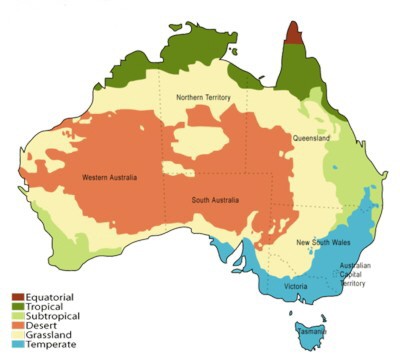Map and Climate of Australia

Because Australia is in the southern hemisphere, the seasons are opposite to those in Europe and North America. Australia is often referred to as a land of diversity in terms of climate: from tropical rainforests, to golden beaches, to sparse deserts, to vast grazing lands to the rich coral reef, bursting with marine life.
Western Australia
During the winter in Western Australia, or “dry” season (April-September), temperatures generally range from 24 degrees Celsius (or 75 degrees Fahrenheit) to around 34°C (93°F). However, average temperatures vary depending on specific location; coastal temperatures tend not to vary much throughout the day, while further inland, the temperature may reach 40°C (104°F), and then plummet towards zero during the night.
During the summer, or “wet” season in Western Australia (October-March), temperatures are generally in the mid to high 30s, with high humidity. People more accustomed to cooler climates may find this weather unpleasant, but visitors looking for some sunshine tend to find it enjoyable.
The southern coastal areas of the South West region of Australia have an average temperature of about 32°C (86°F) in the summer and 14°C (57°F) in the winter.
Northern Territory
Climate in the Northern Territory varies significantly between the northern part (known as the “Top End”), and the southern extremities. In the Top End, the wet season runs from November until April, and typically has high humidity and monsoonal rains and storms. Temperatures run from 25°C (77°F) to 33°C (91°F). The dry season runs from May until October, and is characterized by warm, dry, sunny days and cool nights. Temperatures range from 21°C (69°F) to 32°C (89°F), and humidity levels are much lower than those of the wet season.
In the southern parts of the Northern Territory, the climate is more extreme. The wet season runs from October to April, and daytime temperatures are generally in the high 30s, with cool, dry nights. The dry season runs from May to September, and nighttime temperatures can drop below zero.
South Australia
South Australia’s summer lasts from December to February; the average temperature is 28°C (82°F), but can often reach higher than 30°C (86°F). Northern parts of the state experience extremely hot conditions, as much of these parts are comprised of desert. Nights in these areas are often very cold. Winters in South Australia last from March to November, and most of the rainfall that occurs in this area happens during June, July, and August. Temperatures during this time tend to hover around 16°C (61°F).
Queensland
Queensland experiences warm summers and mild winters. Average summer and winter temperatures in Brisbane range from 9°C (48°F) and 29°C (84°F), while temperatures in Cairns average between 17°C (62°F) and 31°C (87°F).
New South Wales
Temperatures in New South Wales can be very high in the northwest and very cold in the southern alpine regions, but generally the climate across New South Wales is very mild. Over half of New South Wales is arid to semi-arid, but most areas of the eastern portion have a temperate climate and high levels of rainfall, ranging from humid subtropical on the northern coast and oceanic on the southern coast.
Melbourne
Seasons in Melbourne are more varied than those of some other areas in Australia, with warm summers, mild springs and autumns, and crisp winters. Summer in Melbourne last from December to February, autumn from March to May, winter from June to August, and spring from September to November. Top temperatures in Melbourne are usually in January and February, when the weather is often dry with hot spells. June and July are the coldest months, and October is the wettest.
Tasmania
Although it gets both hot and cold, Tasmania has a temperate maritime climate, which means temperatures tend not to very much throughout the year. The warmest months in Tasmania are December, January, February, and March, when temperatures range from 17°-23°C (62°-73°F). Winter runs from May to August, and temperatures generally fall between 3°-11°C (37°-51°F).





